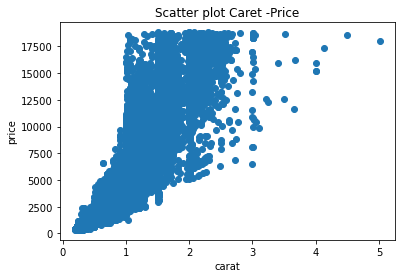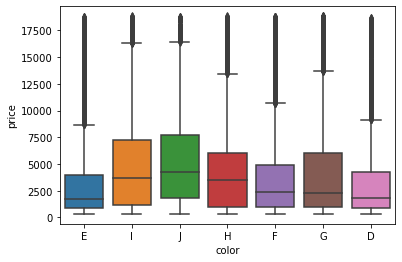다이아몬드 데이터셋
다이아몬드 데이터셋¶
import pandas as pd
df = pd.read_csv('https://raw.githubusercontent.com/Datamanim/dataq/main/diamonds.csv',index_col=0)
Question 1
carat과 price의 경향을 비교하기 위한 scatterplot그래프를 출력하시오
import matplotlib.pyplot as plt
plt.scatter(df['carat'],df['price'])
plt.xlabel('carat')
plt.ylabel('price')
plt.title('Scatter plot Caret -Price')
plt.show()

Question 2
carat과 price사이의 상관계수와 상관계수의 p-value값은?
corr_by_pandas = df[['carat','price']].corr().iloc[0,1]
print(corr_by_pandas)
0.9215913011935697
from scipy import stats
corr_by_scipy ,pv= stats.pearsonr(df['carat'],df['price'])
print(corr_by_scipy)
0.9215913011934769
print(pv)
0.0
Question 3
color에 따른 price 값의 분포는 아래와 같다.
import seaborn as sns
sns.boxplot(data=df,x='color',y='price')
<AxesSubplot:xlabel='color', ylabel='price'>

Question 3-1
Diamond의 평균가격은 3932로 알려져있다. ‘H’ color를 가지는 다이아몬드 집단의 평균에 대한 일표본 t검정을 시행하려한다. 통계량과 pvalue값을 구하시오. 유의수준 0.05에서 귀무가설 채택여부를 boolean 값으로 표현할 변수(hypo) 만들고 출력하시오
H_prop = df[df['color'] == 'H']
static, pv = stats.ttest_1samp(H_prop['price'], 3932)
if pv<0.05:
hypo = False
else:
hypo = True
print(static)
print(pv)
print(hypo)
11.988997411117696
7.569973305218302e-33
False
Question 3-2
그래프상에서 ‘F’와 ‘G’는 평균이 유사해보인다.이를 확인하기 위해 집단간 등분산(levene,fligner,bartlett) 검정을 시행 후 결과를 출력하고조건에 맞는 독립표본 t검정을 시행하라
F = df[df['color'] == 'F']
G = df[df['color'] == 'G']
leve = stats.levene(F['price'], G['price'])
fli = stats.fligner(F['price'], G['price'])
bartlet= stats.bartlett(F['price'], G['price'])
print(leve)
print(fli)
print(bartlet)
LeveneResult(statistic=53.627886257416655, pvalue=2.511093007074788e-13)
FlignerResult(statistic=37.04347553879807, pvalue=1.155244880009172e-09)
BartlettResult(statistic=47.52732212008511, pvalue=5.424264079418252e-12)
등분산 조건 확인시 귀무가설 기각(p-value <0.05), 유의수준하에 ‘F와 G 집단간 분산은 같지 않다’
t_test_FG =stats.ttest_ind(G['price'], F['price'], equal_var = False)
t_test_FG
Ttest_indResult(statistic=5.045279980436125, pvalue=4.5670321227041464e-07)
독립표본 t검정 시행시 귀무가설 기각(p-value <0.05), 유의수준하에 ‘F와 G 집단간 평균은 같지 않다’
Question 3-3
color ‘F’,’G’,’D’ 세집단의 price값들에 대해 anova분석을 시행하라.
등분산검정
D = df[df['color'] == 'D']
levene = stats.levene(F['price'], D['price'], G['price'])
fligner =stats.fligner(F['price'], D['price'], G['price'])
bartlett =stats.bartlett(F['price'], D['price'], G['price'])
print(bartlett)
print(fligner)
print(levene)
BartlettResult(statistic=289.14364432535103, pvalue=1.634012581050329e-63)
FlignerResult(statistic=494.64591695585733, pvalue=3.881538382653518e-108)
LeveneResult(statistic=118.97521469312785, pvalue=3.557425577381817e-52)
정규성검정
print(FG)
print(FD)
print(GD)
KstestResult(statistic=0.06151941343574685, pvalue=1.852300346010811e-17)
KstestResult(statistic=0.09505504118130681, pvalue=6.994405055138486e-15)
KstestResult(statistic=0.12093708375978551, pvalue=2.0167762615717943e-54)
anova = stats.f_oneway(F['price'], D['price'], G['price'])
anova
F_onewayResult(statistic=101.1811790316069, pvalue=1.6513790091285713e-44)
세집단의 분산분석 시행결과 귀무가설을 기각하고 (p-value <0.05) 유의수준 하에서 세집단 중 어느 두집단의 평균은 같지 않다(정확한 검정을 위해서는 사후검정실시해야함)
Question 4
연속형 변수(carat,depth,table,price,x,y,z) 각각의 이상치(1,3분위값에서 IQR*1.5 외의 값) 갯수를 데이터 프레임(변수명 ratio_df, 비율의 내림차순 정렬)으로 아래와 같이 나타내어라.
lst = []
for col in ['carat','depth','table','price','x','y','z']:
target = df[col]
iqr = target.quantile(0.75) - target.quantile(0.25)
outlier = target.loc[(target > target.quantile(0.75) +iqr*1.5) | (target < target.quantile(0.25) - iqr*1.5)]
lst.append([col,len(outlier)])
ratio_df = pd.DataFrame(lst).rename(columns={0:'column',1:'ratio'}).sort_values('ratio',ascending=False)
ratio_df
| column | ratio | |
|---|---|---|
| 3 | price | 3540 |
| 1 | depth | 2545 |
| 0 | carat | 1889 |
| 2 | table | 605 |
| 6 | z | 49 |
| 4 | x | 32 |
| 5 | y | 29 |
Question 5
color에 따른 price의 max, min, 평균값을 colorDf 변수에 저장하고 아래와 같이 출력하는 코드를 작성하라
colorDf = df.groupby(['color'])['price'].agg(['max','min','mean'])
colorDf
| max | min | mean | |
|---|---|---|---|
| color | |||
| D | 18693 | 357 | 3169.954096 |
| E | 18731 | 326 | 3076.752475 |
| F | 18791 | 342 | 3724.886397 |
| G | 18818 | 354 | 3999.135671 |
| H | 18803 | 337 | 4486.669196 |
| I | 18823 | 334 | 5091.874954 |
| J | 18710 | 335 | 5323.818020 |
Question 6
전체 데이터중 color의 발생빈도수에 따라 labelEncoding(빈도수 적은것 : 1, 빈도수 증가할수록 1씩증가)을 하고 colorLabel 컬럼에 저장하고 cut에 따른 colorLabel의 평균값을 구하여라
dic= {x: i+1 for i, x in enumerate(list(df.groupby('color').size().sort_values().index))}
df['colorLabel'] = df['color'].map(lambda x: dic[x])
df['colorLabel'].head(3)
1 6
2 6
3 6
Name: colorLabel, dtype: int64
mean_cut = df.groupby('cut')[['colorLabel']].mean()
mean_cut
| colorLabel | |
|---|---|
| cut | |
| Fair | 4.516770 |
| Good | 4.562780 |
| Ideal | 4.769152 |
| Premium | 4.644913 |
| Very Good | 4.654362 |
Question 7
price의 값에 따른 구간을 1000단위로 나누고 priceLabel 컬럼에 저장하라. 저장시 숫자 순으로 label하고(0~1000미만 : 0,1000이상~2000미만 :1 …) 최종적으로 구간별 갯수(변수명:labelCount)를 출력하라
df['priceLabel'] = df['price'].map(lambda x: x//1000)
labelCount = df[['priceLabel']].value_counts().to_frame().reset_index().rename(columns={0:'counts'})
labelCount
| priceLabel | counts | |
|---|---|---|
| 0 | 0 | 14499 |
| 1 | 1 | 9704 |
| 2 | 2 | 6131 |
| 3 | 4 | 4653 |
| 4 | 3 | 4226 |
| 5 | 5 | 3174 |
| 6 | 6 | 2278 |
| 7 | 7 | 1669 |
| 8 | 8 | 1307 |
| 9 | 9 | 1076 |
| 10 | 10 | 935 |
| 11 | 11 | 824 |
| 12 | 12 | 702 |
| 13 | 13 | 603 |
| 14 | 15 | 514 |
| 15 | 14 | 503 |
| 16 | 16 | 424 |
| 17 | 17 | 406 |
| 18 | 18 | 312 |
